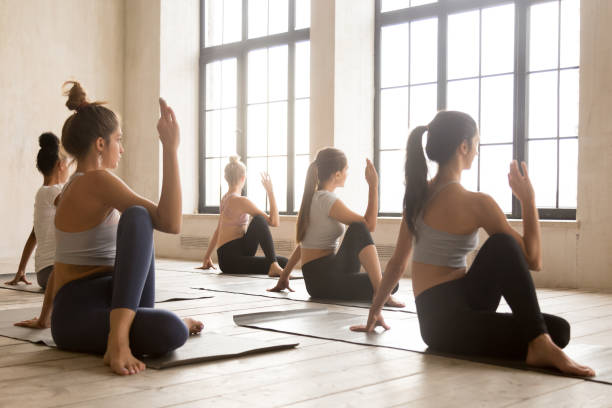What Are The Benefits Of Twists In Yoga? When To Avoid?
Yoga practitioners enjoy twisting in a variety of positions, including lying, sitting, standing, and even upside down. The term “twist” is used to encompass any pose in which the shoulder girdle is turned to face in the opposing direction of the hips. They hold such a special place in yoga for a variety of reasons.
Twists mostly affect our axis, regaining and maintaining the range of motion in and around the spine. It’s far too simple to forget how crucial spine mobility is until dysfunction, discomfort, and pain appear to give us a not-so-gentle reminder. Read on to learn the main advantages of delectable twists, from promoting healthy digestion to energizing the body and mind. Don’t wait until it’s too late.
Table of Contents
Benefits of Twists in Yoga
Improve Digestive Function
Your digestive organs will essentially be compressed when you are in a twist, putting weight on them. Lack of circulation will result from this. When you let go of the twist, your digestive system will experience a rush of new blood. Fresh oxygen and nutrients result from fresh blood flow. Blood flow to the digestive organs will increase as a result of twisting, improving their functionality.
Detox
As was already mentioned, when you twist, the blood supply to your digestive organs is cut off; when you let go of the twist, new blood is introduced to your abdominal organs. This reintroduction of fresh blood can aid in clearing the cells of any accumulated waste because increased circulation also results in increased cellular detoxification. The compression caused by twisting can also aid in assisting the movement of gas and stagnant impurities through your digestive system.
Maintain Normal Spinal Rotation
Over time, the tissues and muscles that surround the spine may stiffen. Reduced mobility, pain, and discomfort, as a result, will have a significant impact on quality of life. The spinal muscles are kept mobile by engaging in twisting postures, which also keeps you mobile.
Reduction in Back Pain
The majority of us regularly slouch over computers at work, slump forward while driving, sit in uncomfortable chairs, and stand with our shoulders hunched forward. Back pain can result from any one of these habits. Twists can significantly reduce the back pain brought on by daily activities by extending and strengthening the back muscles.
De-Stress
If you struggle with stress or anxiety, twists are excellent postures to adopt. These positions will aid in opening the chest, shoulders, and back, all of which can aid in reducing feelings of anxiety. Twisting will cause your body to release tension that has been held in place, which can improve your mental health. If you twist while also taking slow, rhythmic breaths, the effect will be multiplied.
Spine Mobility and Back Health
Twists cause the spine to rotate and the back muscles to be stretched. The spine’s natural range of motion is preserved and restored as a result. We run the risk of our joints hardening and fusing if we don’t use our natural range of motion. Additionally, the nearby supportive soft tissue may get too short and stop working properly. Julie Gudemenstead, a yoga instructor and an expert in anatomy, advises us to prevent this by regularly stretching the muscles to their full length with twists once or twice a day.
Energising
In twists, you work with the spine, and the “lengthening” action results in more space between the vertebrae. Our energy levels decline when there isn’t enough room because our spine tends to sag or become stuck. Twisting lengthens the spine and creates space between the bones. Afterward, our energy will flow more smoothly. Twists provide us with a quick energy boost and safely and healthily decompress the vertebrae.

What Kinds of Twists Are There?
Reclining Twist
Due to the stabilization of the upper body during reclining twists, the lower spine is twisted primarily by rotating the pelvis and legs. Maintaining core stability and checking that your shoulders are firmly planted is crucial in this situation.
Seated and Standing Twists
In both our seated and standing twists, alignment is even more crucial. When performing these twists, you should begin by grounding and lengthening. When performing seated or standing twists, it’s critical to contract the abdominals in order to support the lower back and stabilize the pelvis. As the spine lengthens and moves upward or forward the pelvis grounds.
When to Avoid Twists?
Pregnancy
Because they put pressure on the abdominal cavity, certain twists should be avoided if you’re pregnant. Think of the Twisted Triangle or the Side Angle Revolved Pose. After the first trimester, gentle open twists like Parivritta Janu Sirsasana are safe. If you’re just starting out, it’s best to work with a knowledgeable pregnancy yoga instructor.
Spinal Disc Injury
Ask your physical therapist what exercises are safe for you to perform.
Chronic Digestive Issues
Twists are frequently found to be beneficial for digestive issues, particularly constipation. Asking your doctor for advice is crucial if you experience chronic digestive problems, particularly inflammatory conditions.
Sacroiliac (SI) Joint Issues
You are likely already aware that certain yoga poses won’t be beneficial for you if you have SI joint dysfunction. You can decide what will and won’t work for you by understanding your SI joints and how twisting can affect them. Regarding twists and the SI joint, Yoga Journal has a good article.
Final Thought: Experience It Yourself
Yoga offers a wide variety of poses for you to try. But there are a variety of advantages to the twisting yoga poses that affect your body, mind, and spirit as a whole. Experiencing twists firsthand is the best way to learn about their advantages!





